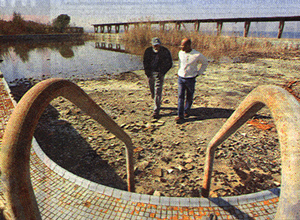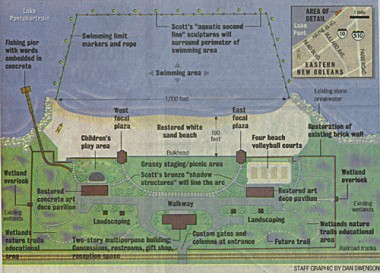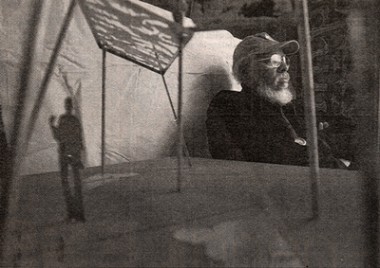A NEW WAVE
By Martin Carr, Staff writer, New Orleans Times-Picayune

- John Scott, left and Shawn Barney, a consultant walk on what was once a huge swimming pool at Lincoln Beach, which will be re-engineered under the plan.
John Scott has spent his life transforming metal and wood into visual stories about black culture in New Orleans.
But the artist’s biggest challenge may be his latest: turning the derelict Lincoln Beach into a premier recreation spot while preserving its rich history through art.
One of the nation’s best known African-American sculptors, Scott recently was enlisted by the New Orleans Building Corp. to work his magic on the segregation-era amusement park that was abandoned after it closed in 1964.
Instead of recommending an exhibit to commemorate the storied past of the African-American only beach, Scott has proposed weaving art throughout the revitalized facility, with custom gates, bronze shelters and floating sculptures in Lake Pontchartrain.
It’s a concept the city hopes will not only result in a first-class attraction on Hayne Boulevard in eastern New Orleans, but an honorable remembrance of the Lincoln Beach that entertained hosts of black families for a decade.
“It was his desire and, our aspiration to bring to the revitalization the voice of Lincoln Beach, the soulfulness of the place,” said Sean Cummings, acting director of the New Orleans Building Corp., an agency created to make money from little-used, city owned property. “His vision will transform a place that might otherwise be clouded by the legacy of segregation into a place of celebration and of healing.”
The Orleans Levee Board opened Lincoln Beach in 1954 as a recreational alternative for African-Americans, who were not admitted to the Pontchartrain Beach amusement park farther west along the lakefront. The smaller park, near the Little Woods subdivision, closed down after Pontchartrain Beach was integrated.
After the rides were dismantled and sold, the site began to deteriorate. It now resembles a war zone, choked with weeds, rotting buildings and swimming pools filled with stagnant water.
Ironically, ongoing analysis by the Lake Pontchartrain Basin Foundation has shown that the water off the beach is among the lake”s cleanest spots.
Despite years of delay due to legal hang-ups and changes in the political landscape, Cummings said the city is optimistic that construction on the project will begin in June, and the beach will be open for swimming by July 4, 2005.
He also said that bringing in an artist of Scott’s caliber to enhance the project represents a major shift from previous concepts that have been considered for the 17-acre property since it was acquired by the city in 1999.
Under former Mayor Marc Morial, an elaborate $20 million revitalization was planned, which included a much larger beach expansion, fountain and entertainment plaza. Mayor Ray Nagin committed to a more modest revitalization that focused on the beach and other public areas at a cost of about $8 million. But as the project stalled due to environmental cleanups and a lawsuit over the demolition, officials with the New Orleans Building Corp searched for a better way to elevate the project from a public park to a cultural attraction.
Before long, they found their answer.

Man with a plan
Project manager Shawn Barney asked Scott, an old family friend, to give his opinion on a proposed design offered by Burk—Kleinpeter and Billes Manning Architects. Scott’s thoughts were so insightful that the city agency asked the artist to join the design team.
“What I saw in my opinion was generic. It could have been anywhere,” Scott said. “I felt like Lincoln Beach had so much history … a history that should not be plowed under.”
Born and raised in the Lower 9th Ward, Scott has received wide critical acclaim for his sculptures, which blend elements of cubist design with traditional African art forms. In 1992, the artist received a $315,000 “Genius Grant” from the MacArthur Foundation, solidifying his reputation as one of the most important local artists in New Orleans.
Several of Scott’s works also have become local landmarks: “Ocean Song,” a glinting kinetic sculpture, is a highlight of Woldenberg Park; “Spirit House,” a collaborative sculpture with artist Martin Payton, can be seen at the DeSaix Boulevard traffic circle; “Spirit Gates” adorns the outside of the New Orleans Museum of Art; and “Riverspirit,” a brightly colored bas relief aluminum sculpture, can be found on the Port of New Orleans building.
The Lincoln Beach project, however, will be one of the largest public commissions the artist has ever undertaken.
“This is an opportunity to visually enshrine the cultural and social history that that place was,” Scott said. “I don’t think it’s often that an artist gets an opportunity to make that kind of statement through their art.”
Scott has plenty of personal experiences to draw on for inspiration.
Scott, 63, said he remembers many summer days in the 1950s and ’60s when he would board an old diesel bus for the hot, dusty drive to Lincoln Beach. The trip took riders past about 175 fishing camps on Lake Pontchartrain, an environment Scott politely describes as “not very welcoming” to African Americans.
Once visitors arrived, however, they were transported into a whole new world, he said. The park was bustling with families who had come to swim in the lake or one of three huge pools. There were roller coasters, bumper cars and shooting galleries. Musicians such as Fats Domino lit up the stage nightly. And there were beauty contests, diving competitions, even a black state fair.
It’s that vibrancy that Scott hopes to communicate through the art he is creating for the beach.
“That place was a cultural, social ecosystem for the community,” Scott said.
Scott once again will team up with sculptor Martin Payton to create and install the art. Payton is a professor at Southern University in Baton Rouge. Scott teaches art at Xavier University.
The current design, expected to be finalized this month, includes the demolition of all existing structures except for two concrete art deco shelters. Cummings said. Crews will restore the original sand beach and build a fishing pier, as well as four sand volleyball courts and a children’s play area. Plans also call for a large grassy staging area and a two-story multi purpose building that will be used for concessions and event rentals.
Officials plan to resurface city-owned property across from the beach on Hayne Boulevard for parking. A portion of the land may also be converted to an RV park, Cummings said.
Art in motion
 Sculptor John Scott is framed by a model of a shadow sculpture scheduled for Lincoln Beach. “I felt like Lincoln Beach had so much history. . . a history that should not be plowed under,” he said.
Sculptor John Scott is framed by a model of a shadow sculpture scheduled for Lincoln Beach. “I felt like Lincoln Beach had so much history. . . a history that should not be plowed under,” he said.
But the defining feature of the Lincoln Beach revitalization will be the art Scott is creating.
The focal point of Scott’s vision is a series of floating sculptures he calls an “aquatic second line.” The 5-foot metal figures of musicians and dancers will be cut in various colors of anodized aluminum, the same material used to create Mardi Gras doubloons. They will then be mounted on 34 buoys around the perimeter of the beach’s designated swimming area in Lake Pontchartrain to “dance” with the wind and wave action, resembling the real-life celebratory processions, he said.
“A lot of my work is kinetic. It moves,” Scott said. “I thought, ”Why not use the buoys to take it to another level?”… Take the wave motion of the water and use it to energize a sculptured statement.”
Scott has also designed a series of 12-foot-high bronze shelters he calls “shadow structures” to be placed along the main thoroughfare of the new park. The sculptures will be constructed of a large metal panel featuring cutouts of musicians and dancers, sitting atop four poles. When the sunlight shines through, the shelters will cast shadows of the figures on the concrete below.
In addition, metal cutouts of famous musicians will be embedded into the concrete walkway below the shadow structures to add to the storytelling effect, Scott said. As visitors pass underneath the structures, a directed sound system will play music from the 1950s and ’60s, as well as anecdotes from New Orleanians who frequented the park in its heyday.
Scott also plans to create metal panels to adorn the gates and columns that will line the entrance of the new park. The gate panels likely will tell the story of the diving competitions and dances that were held there, Scott said. The columns will focus on the plants, insects and wildlife that were prevalent at the old beach.
Finally, Scott plans to embed words that reflect New Orleans culture into the concrete panels that will make up the fishing pier. The text will be laid out in curves that represent the flow of the Mississippi River, he said.
“Consciously or unconsciously people will be walking on this stuff,” Scott said. “This is my way of creating an artistic statement that is both informing and enlightening and elevating all at the same time.”
The project will be paid for with about $8 million in federal, state and city funds that have already been secured. Construction is expected to cost $5 million, with design adding $550,000, Cummings said. The rest of the money has been dedicated to environmental cleanup and demolition.
Both Scott and Cummings say it’s a project — and a vision — that they both are eager to realize.
“If this thing works the way I envision it to work, I think it will be like the Jazzfest,” Scott said. “I want people from all over the world to come. I believe this place is that important.”
